Council Emissions Bounce Back To Pre-Pandemic Levels

A Hamilton City Council report has revealed that operational emissions have risen compared to 2020 – a year that saw Covid-19 lockdowns cause a big drop in emissions.
Council’s emissions profile for 1 July 2020 – 30 June 2021 shows operational emissions at 10,802 tonnes of carbon dioxide equivalents, an increase of 364 tonnes compared to the 2019/2020 period.
However, emissions have still decreased by 1% (130 tonnes) compared to the 2018/2019 baseline levels, when emissions measurement began.
“Our target is to reduce our gross operational emissions by 50% by 2030” said Environment Committee Chair Councillor Martin Gallagher. “However, the road to that goal is not linear. We expect to see some emissions increase as others decrease.”
An example of this was shifting the gas-fired engine at Hamilton’s wastewater treatment plant to emergency backup only, which contributed to a 4% reduction in emissions from natural gas.
Now, electricity is being used to power the plant instead, and emissions from electricity have increased slightly year on year.
Much of the 4.5% decrease in emissions between 2018/19 and 2019/20 is attributed to New Zealand’s first lockdown that lasted over six weeks at Alert Level 4 and 3.
During this time, staff were working from home and all Council facilities were closed, including libraries, Waikato Museum, swimming facilities, sports and events venues, Hamilton Gardens and the Zoo.
Councillor Thomson, Deputy Chair of the Environment Committee says it’s expected to take some time to build up momentum, but these results show that both Council and the Government need to ramp up their efforts.
“Our electricity emissions will reduce as the national grid moves closer to 100% renewable energy, but we need greater speed from the Government on this if we’re to achieve our targets.
“In the meantime, Council is exploring options to generate renewable energy onsite as a way to potentially reduce our reliance on the grid, as well as drive energy efficiency across all of our operations.”
Population growth was a factor in the increase in emissions from biosolids management in the 2020/2021 period.
Biosolid management includes the transport and vermicomposting of Hamilton’s toilet waste, as well as trade waste, such as grease trap waste from hospitality.
Emissions from biosolid management dropped in 2019/2020 as businesses were not operational during lockdown and have risen again on par with the baseline 2018/2019 level.
The end product of biosolid treatment is organic matter that can be used in remediation projects as a soil replacement.
Fuel emissions also dipped last year and are back to pre-pandemic levels. Upcoming fleet projects which include reducing the number of Utes, and switching to hybrid vehicles, should see a decrease in the 2021/2022 emissions profile.
While emissions rose in these key areas, there have been some noteworthy decreases in emissions in 2020/2021.
Air travel emissions have decreased by 84% from the 2018/2019 baseline, and now make up just 0.2% of Council’s emissions.
This decrease can also be attributed to the pandemic, which forged new ways of working with less travel, and more online conferences and meetings.
There has also been a small decrease in emissions from waste, as Council introduced a new rubbish and recycling service to our facilities when the new kerbside service launched in 2020.


 Gordon Campbell: On Justin Trudeau’s Demise, In A Global Context
Gordon Campbell: On Justin Trudeau’s Demise, In A Global Context Climate Justice Taranaki: The Bill For Individualism, Corporations And Neoliberalism
Climate Justice Taranaki: The Bill For Individualism, Corporations And Neoliberalism Ministry For Culture & Heritage: New Zealand Flag Half-Masting To Mark The Funeral Of Senior Sergeant Lyn Fleming, NZ Police
Ministry For Culture & Heritage: New Zealand Flag Half-Masting To Mark The Funeral Of Senior Sergeant Lyn Fleming, NZ Police Child Poverty Action Group: Anti-poverty Groups Say Amendments To Social Security Act Will Remove Job Seekers’ Human Rights
Child Poverty Action Group: Anti-poverty Groups Say Amendments To Social Security Act Will Remove Job Seekers’ Human Rights Justice Committee: Justice Committee Reopens Submissions For Principles Of The Treaty Of Waitangi Bill To Tuesday 14 January
Justice Committee: Justice Committee Reopens Submissions For Principles Of The Treaty Of Waitangi Bill To Tuesday 14 January NZCAST: Survivors Of Abuse In Care Left Waiting - Urgent Action Needed Following Apology
NZCAST: Survivors Of Abuse In Care Left Waiting - Urgent Action Needed Following Apology Ōnuku Rūnanga: No One Wants Wastewater In Akaroa Harbour
Ōnuku Rūnanga: No One Wants Wastewater In Akaroa Harbour


